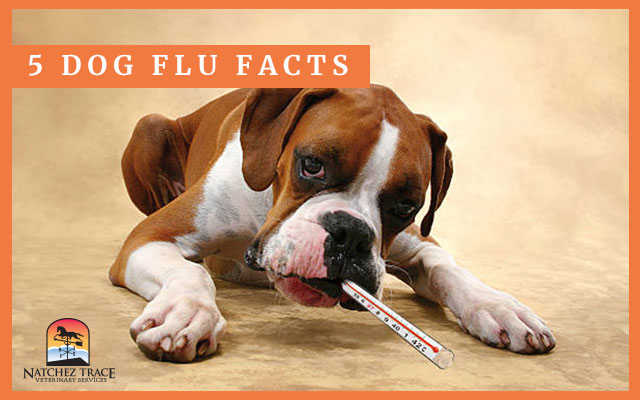DOG FLU. What is it?
How can it affect your pet?
The official name of dog flu is Canine Influenza Virus (CIV), also known as Influenza Type A H3N8.
Canine Influenza Virus has been around for quite a while but seems to be creating quite a stir recently.
Read on to learn the facts on this flu, and decide for yourself how you want to handle it.
Dog Flu Fact #1: Dog Flu Has Been Around for Over a Decade.
Dog Flu has been around for years.
In fact, the virus that causes dog flu (Influenza Type A H3N8) was first identified in Florida in 2004.
According to Merck Animal Health:
We have a concern with this vaccine.
If scientists created the vaccine sometime between 2004 and 2009, how effective will it be in 2015?
We all know that viruses mutate.
Right now, we do not feel this vaccine is necessary.
Dog Flu Fact #2: Dog Flu Affects Each Dog Differently.
The symptoms and effects of dog flu can range from a total absence of symptoms to hemorrhagic pneumonia.
Some dogs exposed to the H3N8 dog flu virus fight off the infection and never show any clinical signs or symptoms.
Some dogs experience a mild manifestation of the virus.
Mild effects include a moist cough and nasal discharge, usually going away on its own within 10-30 days. Some dogs experience a severe manifestation of the virus.
Severely affected dogs develop a high fever (over 104) and very quickly develop a cough and nasal discharge.
In severe cases, the virus affects the lung capillaries, often causing the dog to cough up blood and experience difficulty breathing.
Severe cases may also turn into bacterial pneumonia.
According to Merck Animal Health, approximately 20% of infected dogs will show no clinical signs of H3N8, approximately 80% will experience a mild form of the disease, and approximately 10-20% of infected dogs may progress to a more severe manifestation of the virus.
Dog Flu Fact #3: Dog Flu is Highly Contagious to Other Dogs.
Canine Influenza Virus H3N8 is very contagious dog-to-dog and is transmitted by:
- Respiratory secretions from other dogs through the air via a sneeze or cough
- Contaminated objects like blankets, toys, and dog bowls
- By people moving between infected and uninfected dogs
If your dog is coughing or showing other signs of respiratory disease, you should keep him away from other dogs.
You should also clean and disinfect your hands, clothing, equipment, and surfaces exposed to dogs showing signs of respiratory disease.
Dog Flu Fact #4: You Test Your Dog for Dog Flu
You can test your dog for dog flu at your local vet clinic.
Vets do the test via a nasal swab.
Timing is very important!
You must swab your dog within one or two days of the onset of the symptoms. The reason is that there is only a tiny window of time in which isolation of the virus is successful.
Dog Flu Fact #5: You Can Treat Dog Flu at Home for Most Dogs.
The majority of dogs will only experience mild symptoms of the Canine Influenza Virus. Not all dogs will need therapeutic intervention.
Therapy and treatment consist mostly of supportive care while letting the virus run its course (10-30 days). Dogs that develop secondary infections will need antibiotics.
Dogs with secondary infections will experience fever, purulent nasal discharge, productive cough, and possible pneumonia. Sources:
- US Centers for Disease Control and Prevention
- Merk Animal Health
- PedMD
Powerful Tools for Boosting Your Dog’s Immune System
There are many quick and easy changes you can make at home to help boost your dog’s immune system.
- Learn more about immune boosters.
- Feed an energetically appropriate diet. Feeding your dog energetically appropriate foods naturally brings about balance and health. Learn more on PET | TAO’s recipe page.
- Boost your dog’s immune system with medicinal mushrooms. PET | TAO Complement Immune Mushroom Blend blends together the most powerful immune-boosting medicinal mushrooms on the market in a single product.
- Boost your dog’s gut health. Studies show good gut health promotes better overall immunity. Digestive enzymes and probiotics are a quick, natural way to boost gut health.
- Learn more about TCVM Herbal Remedies. Chinese medicine offers many amazing natural immune boosters. Some good examples are:








